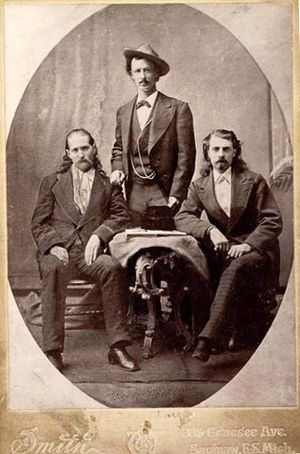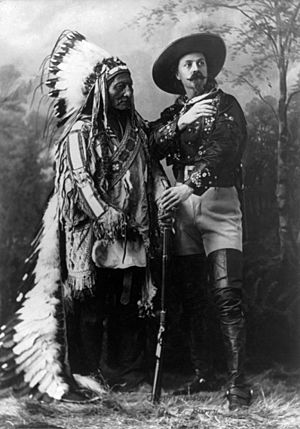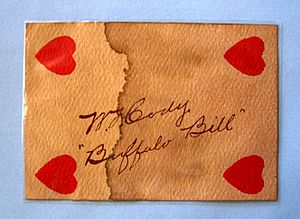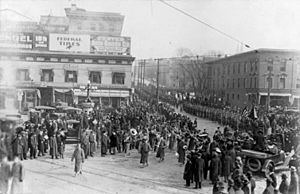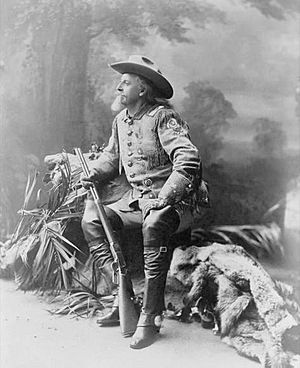Buffalo Bill facts for kids
Quick facts for kids
Buffalo Bill
|
|
|---|---|

Buffalo Bill in 1911
|
|
| Born |
William Frederick Cody
February 26, 1846 Le Claire, Iowa Territory, U.S.
|
| Died | January 10, 1917 (aged 70) Denver, Colorado, U.S.
|
| Resting place | Lookout Mountain, Colorado |
| Other names | Buffalo Bill Cody Pahaska (Long hair) |
| Occupation | Army scout, Pony Express rider, ranch hand, wagon train driver, town developer, railroad contractor, bison hunter, fur trapper, gold prospector, showman |
| Known for | Buffalo Bill's Wild West shows |
| Spouse(s) | |
| Children | 4 |
| Military career | |
| Service/ |
|
| Years of service | 1863–1865, 1868–1872 |
| Rank | Private 2 (Chief of Scouts) |
| Unit | 7th Kansas Cavalry Regiment (Company H) |
| Battles/wars | American Civil War, Indian Wars (16 battles total) |
| Awards | Medal of Honor |
| Signature | |
 |
|
William Frederick Cody (February 26, 1846 – January 10, 1917), famously known as "Buffalo Bill", was an American soldier, bison hunter, and showman. He was born in Le Claire, Iowa Territory (which is now the U.S. state of Iowa). He spent some of his childhood in Canada before his family moved back to the Midwest and settled in the Kansas Territory.
Buffalo Bill began working at age eleven after his father passed away. By age 15, he became a rider for the Pony Express. During the American Civil War, he served the Union Army from 1863 to 1865. Later, he worked as a civilian scout for the U.S. Army during the Indian Wars, earning the Medal of Honor in 1872.
Buffalo Bill became one of the most famous figures of the American Old West. His adventures started to become legendary when he was only 23. Soon after, he began performing in shows that featured cowboy life and stories from the frontier and Indian Wars. In 1883, he created Buffalo Bill's Wild West, a huge show that toured the United States, Great Britain, and Europe.
Contents
Early Life and Adventures
William Cody was born on February 26, 1846, on a farm near Le Claire, Iowa. His father, Isaac Cody, was against slavery. This belief caused problems for their family in Kansas Territory, where there was a lot of conflict over slavery before the Civil War. Isaac was even attacked for his views and later died from related health issues in 1857.
After his father's death, Bill's family faced financial difficulties. At just 11 years old, Bill started working to help. He worked as a "boy extra" for a freight company, riding horses to deliver messages along wagon trains. He also joined Johnston's Army as an unofficial scout, guiding soldiers in Utah.
At 14, in 1860, Cody heard about gold discoveries and headed to the goldfields. On his way, he met a Pony Express agent and became a rider. He worked there until he had to return home to care for his sick mother. While Cody claimed to have many adventurous jobs, some historians say he might have exaggerated a few of his early roles for publicity.
Military Service and Honors
When his mother got better, Cody wanted to join the Union Army during the American Civil War. He was too young at first, but in 1863, at age 17, he enlisted as a private in the 7th Regiment Kansas Volunteer Cavalry. He served until 1865.
In 1866, Cody married Louisa Frederici. They had four children together. The next year, Cody became an Army scout, working between different forts in Kansas. He met famous figures like Wild Bill Hickok and George Armstrong Custer during this time.
In 1867, Cody took a break from the Army to hunt buffalo (American bison). His job was to supply meat to workers building the Kansas Pacific Railway. He became very good at this, earning his famous nickname.
Cody returned to Army service in 1868. He once rode 350 miles in just 58 hours through dangerous territory to deliver messages. Because of this amazing feat, General Philip Sheridan made him the Chief of Scouts for the 5th Cavalry Regiment.
The Medal of Honor
In 1872, Cody received the Medal of Honor for his bravery as an Army scout during the Indian Wars. This is the highest military award in the U.S. However, in 1917, Congress changed the rules for the medal, and many medals given to civilians, including Cody's, were taken back.
Cody's family worked for over 70 years to get his medal back. In 1989, thanks to their efforts and a strong legal argument, the Department of Defense decided to give the Medal of Honor back to Buffalo Bill and other civilian scouts.
How He Became "Buffalo Bill"
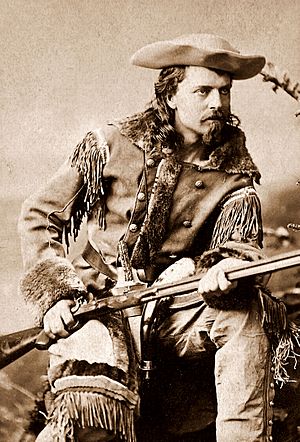
Cody got his nickname "Buffalo Bill" after the Civil War. He had a contract to provide Kansas Pacific Railroad workers with buffalo meat. It's said that he killed 4,282 buffalo in just 18 months in 1867 and 1868. He even won a buffalo-shooting contest against another hunter, Bill Comstock, to keep the famous name.
The Birth of a Legend
In 1869, when Cody was 23, he met a writer named Ned Buntline. Buntline wrote exciting stories about Cody's adventures, though he often made up parts of them. These stories were published in newspapers and popular novels, making Buffalo Bill famous across the country.
Cody later became world-famous for Buffalo Bill's Wild West. This was a huge touring show that traveled around the United States, Great Britain, and Europe. Audiences loved seeing a glimpse of the American West.
Buffalo Bill's Wild West Show
In 1872, Cody started performing on stage with his friend Texas Jack Omohundro in a play called The Scouts of the Prairie. Critics didn't love his acting, but audiences did! In 1873, he invited "Wild Bill" Hickok to join, but Hickok didn't enjoy acting and left after a few months.
In 1883, Cody started Buffalo Bill's Wild West in North Platte, Nebraska. It was like a circus but focused on the American West. He traveled all over the U.S. and Europe with his show, meeting many important people. The show had its own band, led by William Sweeney.
In 1893, Cody changed the show's name to Buffalo Bill's Wild West and Congress of Rough Riders of the World. The show began with a grand parade of horse riders from all over the world, including cowboys, American Indians, Turks, gauchos, Arabs, Mongols, and Georgians.
The show featured amazing skills, races, and side acts. Many real Western figures performed, like Sitting Bull and his warriors. Famous sharpshooters Annie Oakley and her husband, Frank Butler, were also big stars. Performers would re-enact Pony Express rides, Indian attacks on wagon trains, and stagecoach robberies. The show often ended with a scene of cowboys defending a settler's cabin.
The Wild West show greatly influenced how the American West was shown in movies and books for many years. With his earnings, Cody bought a large ranch in Nebraska called Scout's Rest Ranch. It had an 18-room mansion and a big barn for his show's animals.
In 1887, Cody took his show to Great Britain for Queen Victoria's Jubilee celebration. The Queen herself attended a performance! In 1889, the show toured Europe, and in 1890, Cody even met Pope Leo XIII.
In 1893, Cody set up his show near the Chicago World's Fair. Even though the fair had rejected his request to be part of it, his independent show became incredibly popular. In 1894, Buffalo Bill's Wild West was even filmed for an early silent movie. Later, in 1912, Cody appeared in a short film about his life called The Life of Buffalo Bill.
Life in Cody, Wyoming
In 1895, Buffalo Bill helped found the town of Cody in northwestern Wyoming. He was impressed by the area's potential for farming, beautiful scenery, and closeness to Yellowstone Park. He returned in the mid-1890s to start the town, which was officially established in 1901. Streets in Cody are named after his friends and partners.
In 1902, Cody opened the Irma Hotel, named after his daughter. He believed many tourists would come to Cody by train and then travel to Yellowstone Park. He also built other inns along the road to Yellowstone.
Cody also started the TE Ranch near Cody, Wyoming. He raised cattle and ran a "dude ranch" where guests could experience cowboy life, go on pack-horse trips, and hunt. He entertained important guests from Europe and America at his ranch house. He also founded the local newspaper, The Cody Enterprise, in 1899.
Helping with Irrigation
Buffalo Bill saw how much the American West was changing. He realized that to help the land, they needed to control water. In 1897, Cody and his partners worked to get rights to use water from the Shoshone River to irrigate a huge amount of land in the Big Horn Basin.
They started building a canal, but they couldn't raise enough money to finish it. So, in 1903, they asked the government for help. The Shoshone Project became one of the first big water projects by the new Reclamation Service. A dam was built on the Shoshone River, and when it was finished in 1910, it was the tallest dam in the world! Years later, the dam and the lake it created were named Buffalo Bill Dam and Buffalo Bill Reservoir in his honor.
His Marriage
Cody married Louisa Frederici on March 6, 1866, shortly after his 20th birthday. They met in St. Louis during the Civil War. Louisa stayed home with their four children in North Platte, while Cody was often away hunting, scouting, and performing in his Wild West show. Because of his constant travel, they grew apart.
In 1904, after 38 years of marriage, Cody filed for divorce. Divorce was very scandalous back then, and Cody wanted to keep it quiet to protect his show's image. However, Louisa had other ideas, and the case became public.
Cody changed his mind about the divorce after their daughter, Arta Louise, passed away in 1904. He tried to reconcile for the funeral, but Louisa was too upset. The divorce trial continued in 1905, but the court decided that "incompatibility" was not a reason for divorce, so they remained legally married. They eventually reconciled in 1910, and Louisa often traveled with him until he died in 1917.
Death and Burial
Buffalo Bill died on January 10, 1917. Tributes came from leaders around the world, including King George V of Britain, Kaiser Wilhelm II of Germany, and U.S. President Woodrow Wilson.
Cody's fortune had shrunk by the time he died. He left his burial plans to his wife, Louisa. She said he always wanted to be buried on Lookout Mountain in Golden, Colorado, which overlooks the Rocky Mountains and the Great Plains. His sister chose the exact spot.
On June 3, 1917, Cody was buried on Lookout Mountain. There are still rumors that his body might have been secretly moved to Cody, Wyoming, the town he founded. In 1948, a group in Cody, Wyoming, even offered a reward to anyone who could "steal" his body and bring it there!
His Beliefs and Legacy
As a frontier scout, Cody respected Native Americans and supported their civil rights. He hired many Native Americans for his show, believing it offered them good pay and a chance to improve their lives. He called them "the former foe, present friend, the American." He once said that "every Indian outbreak that I have ever known has resulted from broken promises and broken treaties by the government."
Cody also supported the rights of women. He believed women should have more freedom and be paid the same as men if they did the same work. Famous women like Annie Oakley and Calamity Jane had important roles in his show.
In his shows, Native Americans were often shown attacking stagecoaches, but Cody also wanted audiences to see their human side. He encouraged the wives and children of his Native American performers to set up their camps just like they would in their homelands.
Cody was also a conservationist. He spoke out against hunting too many bison and supported having a hunting season to protect animals.
Honors and Tributes
- The Buffalo Bill Cody Scenic Byway in Shoshone National Forest is named after him.
- The Buffalo Bill Dam, the Buffalo Bill Reservoir, and the Buffalo Bill State Park are all named in his honor because of his work on the Shoshone Project.
- The Buffalo Bill Ranch State Park in North Platte, Nebraska, where he lived, is a historical park.
- Cody has been honored with two U.S. postage stamps.
- The Buffalo Bill Center of the West museum is in Cody, Wyoming, the town he helped found.
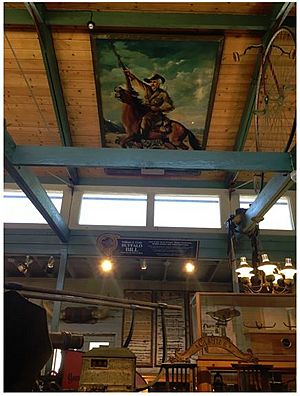
- The National Museum of American History at the Smithsonian Institution has photographs of his Wild West show.
- The Buffalo Bills, a National Football League team from Buffalo, New York, are named after him.
- In 1958, he was added to the Hall of Great Westerners at the National Cowboy & Western Heritage Museum.
- Bubble O' Bill, a cowboy-shaped ice cream in Australia, is named after him.
Statues of Buffalo Bill
Many statues honor Buffalo Bill:
- "The Scout" (1924) by Gertrude Vanderbilt Whitney in Cody, Wyoming.
- "Buffalo Bill – Plainsman" (1976) by Bob Scriver in Cody, Wyoming.
- "The Spirit of Cody" (1999) by Jeffery B. Rudolph in Cody, Wyoming.
- "Born Under a Wandering Star" by Vic Payne in Cody, Wyoming.
- "Howdy Folks" (2000) by Jeffery Rudolph in Golden, Colorado.
- "Buffalo Bill Monument" (2004) by Charlie Norton in Oakley, Kansas.
- A statue at the National Cowboy & Western Heritage Museum in Oklahoma City.
- A "Buffalo Bill Statue" (2006) in Glasgow, Scotland.
- A figure resembling Buffalo Bill is part of the "America" sculpture (1876) by John Bell (sculptor) in Hyde Park, London.
Images for kids
See also
 In Spanish: Buffalo Bill para niños
In Spanish: Buffalo Bill para niños
- Buffalo Bill Cody Homestead
- List of Medal of Honor recipients for the Indian Wars
- Pony Express
- Show Indians
- Wild Westing


